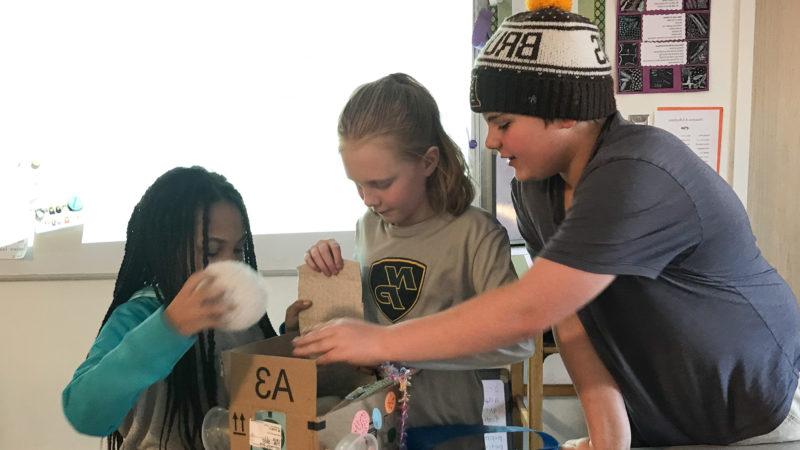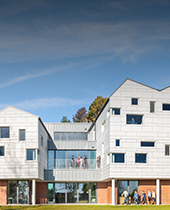《低年级新工程
Students in Waynflete’s 4-5 program engage 在设计 thinking
How can Peter keep his snowball from melting? What will Nanette do to resist eating the baguette on the way home from the store? 先生将如何. McGreely stop rabbits from eating his garden vegetables? Inspired by the characters in Ezra Jack Keats’s 下雪天莫·威廉姆斯的 纳内特的面包坎迪斯·弗莱明和G. 布莱恩·卡拉斯的 Muncha! Muncha! Muncha!, students in Waynflete’s 4-5 program recently immersed themselves in the “design thinking” methodology.
 Design thinking emerged as a concept in the 1950s when strategists began to formalize a series of repeatable stages that would allow a team to reach the best solution based on group skills and available resources. The process was later adapted for business settings by IDEO founder David M. 凯利. 设计思维始于 同理心: putting yourself in the shoes of people, 组织, or—in the case of 4-5 students—book characters who are experiencing a problem. 正如凯利在他的书中所写, 创造性思维, 同理心 is the foundation of innovative design, allowing teams to more accurately 定义问题. 意念 遵循, with team members calling on their individual skills and passions to brainstorm potential solutions. 然后团队发展 原型 或者模型. Finally, teams solicit feedback from others during the final 测试 stage, making revisions where necessary.
Design thinking emerged as a concept in the 1950s when strategists began to formalize a series of repeatable stages that would allow a team to reach the best solution based on group skills and available resources. The process was later adapted for business settings by IDEO founder David M. 凯利. 设计思维始于 同理心: putting yourself in the shoes of people, 组织, or—in the case of 4-5 students—book characters who are experiencing a problem. 正如凯利在他的书中所写, 创造性思维, 同理心 is the foundation of innovative design, allowing teams to more accurately 定义问题. 意念 遵循, with team members calling on their individual skills and passions to brainstorm potential solutions. 然后团队发展 原型 或者模型. Finally, teams solicit feedback from others during the final 测试 stage, making revisions where necessary.
Tufts University adapted the design thinking protocol for elementary schools through its “Novel Engineering” program, which reinforces literacy skills by asking students to engage deeply with narratives by empathizing with characters’ problems. Picture books are exceptional vehicles for introducing the design thinking process to younger students— they show, 用一种简洁的方式, the basic problem/solution structure of a story, and the development of the books’ characters as the plot progresses.
 With help from 较低的学校 Librarian Laurel Daly, students in the 4-5 program began by considering the word “novel”—its two meanings (a book, and a new experience) and how both meanings applied to the project. As they explored illustrations and text, students used visual thinking strategies to gain 同理心 for the books’ characters. Nanette’s facial and body expressions, 例如, made it clear how much she struggled with resisting the warm, 美妙的面包, and how devastated she was when she couldn’t. The students could relate to those emotions.
With help from 较低的学校 Librarian Laurel Daly, students in the 4-5 program began by considering the word “novel”—its two meanings (a book, and a new experience) and how both meanings applied to the project. As they explored illustrations and text, students used visual thinking strategies to gain 同理心 for the books’ characters. Nanette’s facial and body expressions, 例如, made it clear how much she struggled with resisting the warm, 美妙的面包, and how devastated she was when she couldn’t. The students could relate to those emotions.
After defining the problems that the characters were experiencing, group members brainstormed a list of possible solutions. They chose one approach to develop as a prototype that they would build with reusable materials, 包括蛋盒, 塑料吸管, 纸板, 酸奶容器. 学生们测试了他们的原型, 与他人分享, and incorporated revisions based on feedback.
 较低的学校 Director Anne Hopkins contends that design thinking is an educational imperative. “Children today want instantaneous answers,” she says. “But learning is still about revising and revising again, in a collaborative way. We have no idea what kind of problems today’s students will be tackling when they enter the workforce. But we do know that they’ll have to be able to work effectively with communities of people.”
As students move on to Waynflete’s middle and upper schools, they use more complex tools to address more abstract problems that they encounter. Programmable Legos become coding languages; the challenge might be to test a geometry proof or evaluate a chemical reaction.
较低的学校 Director Anne Hopkins contends that design thinking is an educational imperative. “Children today want instantaneous answers,” she says. “But learning is still about revising and revising again, in a collaborative way. We have no idea what kind of problems today’s students will be tackling when they enter the workforce. But we do know that they’ll have to be able to work effectively with communities of people.”
As students move on to Waynflete’s middle and upper schools, they use more complex tools to address more abstract problems that they encounter. Programmable Legos become coding languages; the challenge might be to test a geometry proof or evaluate a chemical reaction.
 Design thinking accommodates all kinds of learners and personality types. The challenge for a “go-getter”-type student, 例如, might be to embrace other children’s ideas and contributions. Some students may prefer to research facts and obtain data, 而其他人可能更喜欢, 正如安妮所说, “to dress up as a light switch as part of a skit on the importance of turning off the lights.”
Design thinking accommodates all kinds of learners and personality types. The challenge for a “go-getter”-type student, 例如, might be to embrace other children’s ideas and contributions. Some students may prefer to research facts and obtain data, 而其他人可能更喜欢, 正如安妮所说, “to dress up as a light switch as part of a skit on the importance of turning off the lights.”
With the 较低的学校’s emphasis on an emergent curriculum, Waynflete teachers are already well-positioned to show children how they can be agents in bringing about change. “Things can go awry during the experimentation phase of the design thinking protocol, 但这是过程的一部分,安妮说。. “We can set up comfortable boundaries while embracing the remarkable things that kids can come up with on their own. There is no ‘single path’ that teachers must show their students.”
 Kids love the design thinking protocol. They relish being given a new kind of freedom to explore and fully exercise their creativity, 无论是在建筑方面, 在设计, 或者只是想出一些离谱的想法. “When students are engaged 在设计 thinking, the energy in the room is palpable. We discovered that the groups wanted to keep working on their 原型 in their own time, 在休息的时候,安妮说。. “We said to them, ‘You want to keep going? 去吧! 没有什么能阻止你!’ I believe that if we give kids the opportunity to find their own solutions to real-life problems—and get out of their way when it’s appropriate—they will be well-poised to continue doing so in the world.”
Kids love the design thinking protocol. They relish being given a new kind of freedom to explore and fully exercise their creativity, 无论是在建筑方面, 在设计, 或者只是想出一些离谱的想法. “When students are engaged 在设计 thinking, the energy in the room is palpable. We discovered that the groups wanted to keep working on their 原型 in their own time, 在休息的时候,安妮说。. “We said to them, ‘You want to keep going? 去吧! 没有什么能阻止你!’ I believe that if we give kids the opportunity to find their own solutions to real-life problems—and get out of their way when it’s appropriate—they will be well-poised to continue doing so in the world.”
读到 Tufts University’s “Novel Engineering” program.




